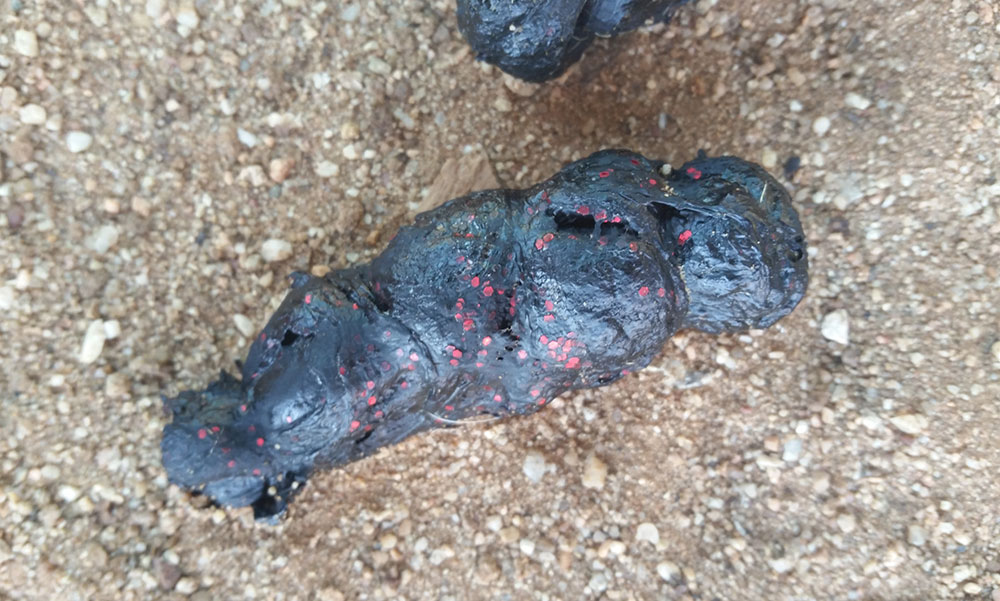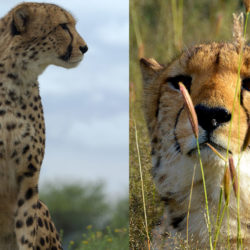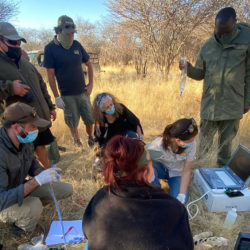All That Glitters is Not Gold
-

- by Becky Johnston January 7, 2021

To some, looking after 40 captive cheetahs might sound like a dream job. Feeding them, exercising them, just being around them all day sounds like an amazing job – and it is! However, some people forget the other half of animal care – cleaning! And a big part of cleaning involves picking up scat, or poop, every single day. And with 40 cheetahs currently at our center here in Namibia, that means a lot of scat! However, this is one of the most important parts of the daily care of the animals.
Like most wild animals, cheetahs are very good at hiding pain, or sickness. By being able to pick up very subtle signs early on, we are able to catch health problems early, and treat them before having to bring an animal into the veterinary clinic. Small changes in behaviour, appetite, but also in things like the consistency or smell of their poop can tell us a lot about their health. It is important that we not only pick up the poop every day for hygiene and cleanliness, but also as a way to do a health check on all of our animals.
We analyze captive cheetah scat for a couple different purposes here at CCF. On the husbandry side, we collect a scat sample from every individual once every three months for parasitology – to check for any internal parasites like worms that might be living in the cheetahs. We also collect a sample from our male cheetahs once a month for hormone analysis. It is illegal to breed any large carnivore in captivity here in Namibia, so if we have mixed groups of males and females, our males are either castrated, or they are on a Deslorelin contraceptive implant, a form of birth control for cheetahs. It can be used on the female cheetahs, however, there can be drawbacks to this including diseases such as cancers becoming prevalent in females that had the implant. Because it was a new method to use it in male cheetahs, CCF has been collecting data since 2012 on the long term effects on hormone levels.


In order to collect these samples every month, we need to know which scat sample collected belongs to which cheetah. While some of our cats have very specific spots they will always poop, we cannot always guarantee which sample belongs to whom. To identify the individual scat sample in the enclosure we use glitter! Yes, arts and crafts glitter! It is non-toxic, and does not get digested. We put in on their piece of meat, and it comes out the other end in their poop! You could also use other non-digestible material such as rice, lentils or beans, as long as it is not poisonous to cheetahs. But picking up “sparkle poop” once a month sounds like a lot more fun, and the interns always have a fun time hunting for specific colours in the enclosures.
It is possible we could collect this data in a different way, for example through blood draws once a month. The biggest thing about collecting scat, is that while it may be smelly, it is non-invasive. At CCF, the Cheetah husbandry and care team do a lot of training with our captive cheetahs in order to make procedures like blood draws as calm and comfortable as we can, but some cheetahs still do not like it, no matter how much training we do. By collecting scat, we do not need to anesthetize the animal and we do not need to restrain the animal in any way. They can go about their normal day, and do their daily business, and we still will get the same results.
We don’t just collect scat from our captive cheetahs at CCF. Thanks to the work of our scat detection dogs and their handler Tim Hofmann who visit farms and find scat from wild free roaming populations on farms, we consistently have new samples from wild cheetahs to analyze and study, allowing us to gain valuable insight to the wild cheetah population here in Namibia. We can look at the health of the animal through parasitology, but we can also extract DNA from that scat in our genetics lab and see exactly who that individual is. Multiple samples from multiple individuals allows us to put together a picture of the wild population not only on our farm, but also all across Namibia. We can also figure out what the animal has been eating through hair analysis. Hair from prey is not digested and will also be found in the scat sample. By looking at the hair closely under a microscope, we are able to identify what species was eaten. This helps us in human wildlife conflict cases, as we are able to determine whether a cheetah on a farm truly is a “problem” animal that has been eating goats or sheep, or if they are hunting their normal prey by doing hair analysis on a fresh scat sample.
There is a reason we call cheetah scat “black gold” here at CCF. One tiny piece of scat from a captive or wild cheetah can tell us almost anything we want to know and allow our conservation efforts to move forward to save this amazing species.
Related Reading
-
May 8, 2025
Help T-Swift to Begin Again -
April 5, 2022
Eulogies for Ron and Khayjay -
November 5, 2021
Field Scans and Clinic Exams with SoundVet




